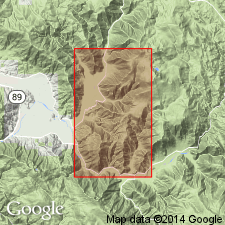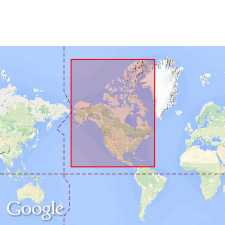
- Usage in publication:
-
- Moonshine formation
- Modifications:
-
- Named
- Dominant lithology:
-
- Conglomerate
- AAPG geologic province:
-
- Sierra Nevada province
Summary:
Name is of geographic origin [geographic feature not stated]. Also referred to as Moonshine conglomerate. Occurs most abundantly on southwest slope of Mount Jura just below 4500-ft elevation, Plumas Co, CA. Lower part consists of ordinary conglomerate bearing cobbles of granitic plutonic origin and ancient red porphyries. Grades upward into red conglomerate, red shale, and finally red tuff. Thickness is 300 ft. Overlies Mormon formation; underlies Hull formation. Age is middle Middle Jurassic.
Source: GNU records (USGS DDS-6; Menlo GNULEX).

- Usage in publication:
-
- Moonshine Conglomerate*
- Modifications:
-
- Adopted
- Biostratigraphic dating
- AAPG geologic province:
-
- Sierra Nevada province
Summary:
Moonshine Conglomerate of Crickmay (1933) adopted. Correlation chart shows unit is agglomerate and red shale (300 ft thick). Overlies Mormon Sandstone; unconformably underlies unnamed dacite tuff-breccia. Is early late Bajocian (Middle Jurassic) age based on ammonite fragments of SPIROCERAS BIFURCATUM (Quenstadt).
Source: GNU records (USGS DDS-6; Menlo GNULEX).
For more information, please contact Nancy Stamm, Geologic Names Committee Secretary.
Asterisk (*) indicates published by U.S. Geological Survey authors.
"No current usage" (†) implies that a name has been abandoned or has fallen into disuse. Former usage and, if known, replacement name given in parentheses ( ).
Slash (/) indicates name conflicts with nomenclatural guidelines (CSN, 1933; ACSN, 1961, 1970; NACSN, 1983, 2005, 2021). May be explained within brackets ([ ]).

